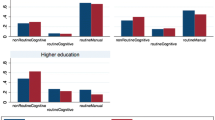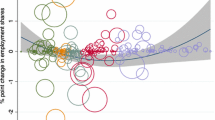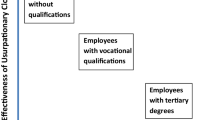Abstract
Autor and Dorn (Am Econ Rev 103(5):1553–1597, 2013) provide an explanation of the polarization of US employment and wages for the period 1980–2005. Using the 1980 Census and 2005 American Community Survey data, this study replicates the estimation results of Autor and Dorn (2013) for employment polarization in all major occupation groups and qualitatively matches the wage polarization results. Also, we investigate the puzzle of why employment and wages changed in opposite directions only in clerical and administrative support occupations in 1980–2005.

Similar content being viewed by others
Change history
09 June 2023
A Correction to this paper has been published: https://doi.org/10.1007/s00181-023-02440-8
Notes
Autor and Dorn (2013) show that only clerical employment and wages moved strongly in opposite directions, exhibiting a pattern opposite to those of the other five broadly classified occupations that the authors consider.
As shown in Appendix Table 1, the employment share of clerical, administrative support, and retail sales occupations fell from 22.2 to 20.4, and hourly wages increased from 2.42 to 2.60.
The six occupation groups are (i) service, (ii) transportation, construction, mechanics, mining, and farming, (iii) managers, professional, finance, and public safety, (iv) administrative support and retail sales, (v) precision and production craft workers, and (vi) machine operators and assemblers.
We briefly describe the data cleaning procedures in the “Appendix”.
Autor and Dorn (2013) show employment polarization results in Table 7 panel A.
We have 722 CZ-level observations in both periods 1980 and 2005. Hence, \(\Delta ln \bar{w}_{jt}\) also have 722 commuting zone-level observations for the decade 1980–2005.
As shown in Table 2, during the period 1980–2005, the employment share of noncollege workers decreased by \(-\)0.60, which is approximately 44% (= \(-\)0.060/0.137), and college workers increased by 0.016, which is around 14% (= 0.016/0.117).
As shown in Panel B and Panel C of Table 2, the high-to-low-skill labor supply ratio in above-median CZs is 0.247 (= 0.885-\(-\)0.638) more than the CZs, which had RSH below the national median in 1980.
These four groups are: (i) minimum wage to 10 dollars, (ii) 10–15 dollars, (iii) 15–20 dollars, and (iv) equal and more than 20 dollars.
As shown in Appendix Tables 7 and 8, the employment share of both college and noncollege workers decreased in two other high routine content occupation groups. We do not observe this pattern in administrative support and retail sales occupations in Table 3. Furthermore, Comparing the results of Table 3 with Appendix Tables 9 and 10, we find that the pattern of changes in the employment share of more productive and least efficient workers in clerical occupations is different than the pattern we observe in two other high routine content occupation groups.
The data for personal computer adoption rate in work in the US and the measure of computerization are discussed in the Appendix.
References
Acemoglu D, Restrepo P (2017) Secular stagnation? The effect of aging on economic growth in the age of automation. Am Econ Rev 107(5):174–179
Autor D, Dorn D (2013) The growth of low-skilled service jobs and polarization of the US labor market. Am Econ Rev 103(5):1553–1597
Autor D, Katz L, Kearney M (2008) Trends in U.S. wage inequality: revising the revisionists. Rev Econ Stat 90(2):300–23
Autor D, Dorn D, Hanson G (2013) The China syndrome: local labor market effects of import competition in the United States. Am Econ Rev 103(6):2121–2168
Basso G, Peri G, Rahman AS (2020) Computerization and immigration: theory and evidence from the United States. Can J Econ 53(4):1457–1494
Chetverikov D, Larsen B, Palmer C (2016) IV quantile regression for group-level treatments, with an application to the distributional effects of trade. Econometrica 84(2):809–833
Author information
Authors and Affiliations
Corresponding author
Additional information
Publisher's Note
Springer Nature remains neutral with regard to jurisdictional claims in published maps and institutional affiliations.
Zexuan Liu acknowledges the financial support of the National Natural Science Foundation of China (grant no. 72103098).
Supplementary Information
Below is the link to the electronic supplementary material.
Rights and permissions
Springer Nature or its licensor (e.g. a society or other partner) holds exclusive rights to this article under a publishing agreement with the author(s) or other rightsholder(s); author self-archiving of the accepted manuscript version of this article is solely governed by the terms of such publishing agreement and applicable law.
About this article
Cite this article
Ghosh, P., Liu, Z. The puzzle of changes in employment and wages in routine task-intensive occupations. Empir Econ 65, 1965–1980 (2023). https://doi.org/10.1007/s00181-023-02394-x
Received:
Accepted:
Published:
Issue Date:
DOI: https://doi.org/10.1007/s00181-023-02394-x




